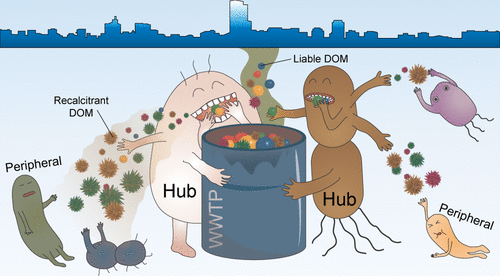当前位置:
X-MOL 学术
›
Environ. Sci. Technol.
›
论文详情
Our official English website, www.x-mol.net, welcomes your
feedback! (Note: you will need to create a separate account there.)
Microbial Roles in Dissolved Organic Matter Transformation in Full-Scale Wastewater Treatment Processes Revealed by Reactomics and Comparative Genomics
Environmental Science & Technology ( IF 10.8 ) Pub Date : 2021-08-02 , DOI: 10.1021/acs.est.1c02584 Liye Wang 1 , Yuan Lin 1 , Lin Ye 1 , Yuli Qian 1 , Yufei Shi 1 , Ke Xu 1 , Hongqiang Ren 1 , Jinju Geng 1
Environmental Science & Technology ( IF 10.8 ) Pub Date : 2021-08-02 , DOI: 10.1021/acs.est.1c02584 Liye Wang 1 , Yuan Lin 1 , Lin Ye 1 , Yuli Qian 1 , Yufei Shi 1 , Ke Xu 1 , Hongqiang Ren 1 , Jinju Geng 1
Affiliation

|
Understanding the degradation of dissolved organic matter (DOM) is vital for optimizing DOM control. However, the microbe-mediated DOM transformation during wastewater treatment remains poorly characterized. Here, microbes and DOM along full-scale biotreatment processes were simultaneously characterized using comparative genomics and high-resolution mass spectrometry-based reactomics. Biotreatments significantly increased DOM’s aromaticity and unsaturation due to the overproduced lignin and polyphenol analogs. DOM was diversified by over five times in richness, with thousands of nitrogenous and sulfur-containing compounds generated through microbe-mediated oxidoreduction, functional group transfer, and C–N and C–S bond formation. Network analysis demonstrated microbial division of labor in DOM transformation. However, their roles were determined by their functional traits rather than taxa. Specifically, network and module hubs exhibited rapid growth potentials and broad substrate affinities but were deficient in xenobiotics-metabolism-associated genes. They were mainly correlated to liable DOM consumption and its transformation to recalcitrant compounds. In contrast, connectors and peripherals were potential degraders of recalcitrant DOM but slow in growth. They showed specialized associations with fewer DOM molecules and probably fed on metabolites of hub microbes. Thus, developing technologies (e.g., carriers) to selectively enrich peripheral degraders and consequently decouple the liable and recalcitrant DOM transformation processes may advance DOM removal.
中文翻译:

反应组学和比较基因组学揭示微生物在大规模废水处理过程中溶解有机物转化中的作用
了解溶解有机物 (DOM) 的降解对于优化 DOM 控制至关重要。然而,在废水处理过程中微生物介导的 DOM 转化仍然很差。在这里,使用比较基因组学和基于高分辨率质谱的反应组学同时表征了全面生物处理过程中的微生物和 DOM。由于过度生产的木质素和多酚类似物,生物处理显着增加了 DOM 的芳香性和不饱和度。DOM 的丰富度增加了五倍以上,通过微生物介导的氧化还原、官能团转移以及 C-N 和 C-S 键的形成,产生了数千种含氮和含硫化合物。网络分析证明了微生物在 DOM 转化中的分工。然而,它们的作用是由它们的功能特征决定的,而不是由分类群决定的。具体而言,网络和模块中心表现出快速增长潜力和广泛的底物亲和力,但缺乏异生物质代谢相关基因。它们主要与易消耗的 DOM 及其向顽固化合物的转化有关。相比之下,连接器和外围设备是顽固的 DOM 的潜在降解者,但增长缓慢。它们显示出与较少 DOM 分子的特殊关联,并且可能以中心微生物的代谢物为食。因此,开发技术(例如,载体)以选择性地富集外围降解物并因此解耦容易和顽固的 DOM 转化过程可能会促进 DOM 的去除。网络和模块中心表现出快速增长潜力和广泛的底物亲和力,但缺乏异生物质代谢相关基因。它们主要与易消耗的 DOM 及其向顽固化合物的转化有关。相比之下,连接器和外围设备是顽固的 DOM 的潜在降解者,但增长缓慢。它们显示出与较少 DOM 分子的特殊关联,并且可能以中心微生物的代谢物为食。因此,开发技术(例如,载体)以选择性地富集外围降解物并因此解耦容易和顽固的 DOM 转化过程可能会促进 DOM 的去除。网络和模块中心表现出快速增长潜力和广泛的底物亲和力,但缺乏异生物质代谢相关基因。它们主要与易消耗的 DOM 及其向顽固化合物的转化有关。相比之下,连接器和外围设备是顽固的 DOM 的潜在降解者,但增长缓慢。它们显示出与较少 DOM 分子的特殊关联,并且可能以中心微生物的代谢物为食。因此,开发技术(例如,载体)以选择性地富集外围降解物并因此解耦容易和顽固的 DOM 转化过程可能会促进 DOM 的去除。它们主要与易消耗的 DOM 及其向顽固化合物的转化有关。相比之下,连接器和外围设备是顽固的 DOM 的潜在降解者,但增长缓慢。它们显示出与较少 DOM 分子的特殊关联,并且可能以中心微生物的代谢物为食。因此,开发技术(例如,载体)以选择性地富集外围降解物并因此解耦容易和顽固的 DOM 转化过程可能会促进 DOM 的去除。它们主要与易消耗的 DOM 及其向顽固化合物的转化有关。相比之下,连接器和外围设备是顽固的 DOM 的潜在降解者,但增长缓慢。它们显示出与较少 DOM 分子的特殊关联,并且可能以中心微生物的代谢物为食。因此,开发技术(例如,载体)以选择性地富集外围降解物并因此解耦容易和顽固的 DOM 转化过程可能会促进 DOM 的去除。
更新日期:2021-08-17
中文翻译:

反应组学和比较基因组学揭示微生物在大规模废水处理过程中溶解有机物转化中的作用
了解溶解有机物 (DOM) 的降解对于优化 DOM 控制至关重要。然而,在废水处理过程中微生物介导的 DOM 转化仍然很差。在这里,使用比较基因组学和基于高分辨率质谱的反应组学同时表征了全面生物处理过程中的微生物和 DOM。由于过度生产的木质素和多酚类似物,生物处理显着增加了 DOM 的芳香性和不饱和度。DOM 的丰富度增加了五倍以上,通过微生物介导的氧化还原、官能团转移以及 C-N 和 C-S 键的形成,产生了数千种含氮和含硫化合物。网络分析证明了微生物在 DOM 转化中的分工。然而,它们的作用是由它们的功能特征决定的,而不是由分类群决定的。具体而言,网络和模块中心表现出快速增长潜力和广泛的底物亲和力,但缺乏异生物质代谢相关基因。它们主要与易消耗的 DOM 及其向顽固化合物的转化有关。相比之下,连接器和外围设备是顽固的 DOM 的潜在降解者,但增长缓慢。它们显示出与较少 DOM 分子的特殊关联,并且可能以中心微生物的代谢物为食。因此,开发技术(例如,载体)以选择性地富集外围降解物并因此解耦容易和顽固的 DOM 转化过程可能会促进 DOM 的去除。网络和模块中心表现出快速增长潜力和广泛的底物亲和力,但缺乏异生物质代谢相关基因。它们主要与易消耗的 DOM 及其向顽固化合物的转化有关。相比之下,连接器和外围设备是顽固的 DOM 的潜在降解者,但增长缓慢。它们显示出与较少 DOM 分子的特殊关联,并且可能以中心微生物的代谢物为食。因此,开发技术(例如,载体)以选择性地富集外围降解物并因此解耦容易和顽固的 DOM 转化过程可能会促进 DOM 的去除。网络和模块中心表现出快速增长潜力和广泛的底物亲和力,但缺乏异生物质代谢相关基因。它们主要与易消耗的 DOM 及其向顽固化合物的转化有关。相比之下,连接器和外围设备是顽固的 DOM 的潜在降解者,但增长缓慢。它们显示出与较少 DOM 分子的特殊关联,并且可能以中心微生物的代谢物为食。因此,开发技术(例如,载体)以选择性地富集外围降解物并因此解耦容易和顽固的 DOM 转化过程可能会促进 DOM 的去除。它们主要与易消耗的 DOM 及其向顽固化合物的转化有关。相比之下,连接器和外围设备是顽固的 DOM 的潜在降解者,但增长缓慢。它们显示出与较少 DOM 分子的特殊关联,并且可能以中心微生物的代谢物为食。因此,开发技术(例如,载体)以选择性地富集外围降解物并因此解耦容易和顽固的 DOM 转化过程可能会促进 DOM 的去除。它们主要与易消耗的 DOM 及其向顽固化合物的转化有关。相比之下,连接器和外围设备是顽固的 DOM 的潜在降解者,但增长缓慢。它们显示出与较少 DOM 分子的特殊关联,并且可能以中心微生物的代谢物为食。因此,开发技术(例如,载体)以选择性地富集外围降解物并因此解耦容易和顽固的 DOM 转化过程可能会促进 DOM 的去除。















































 京公网安备 11010802027423号
京公网安备 11010802027423号